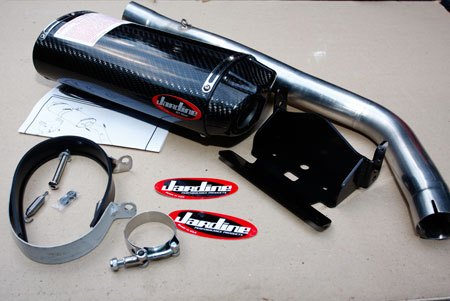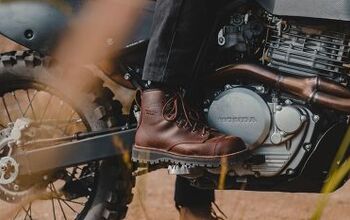Jardine RT-One Slip-On Exhaust Install
It’s always exciting when you receive a package in the mail and it’s even better when it’s a new part for you pride and joy. When the big white box labeled “Jardine” showed up we were as happy as a little school girl with a new kitten.
Neatly packed inside the box was a Jardine Performance Products RT-One slip-on carbon fiber exhaust ($678) and a Pro Tune 3 fuel programming card ($310) for our 2007 Honda CBR600RR.
As soon as we opened up the box we were itching to install the new goodies and find out how they performed. We installed the exhaust first, which wasn’t too difficult an operation, but knowing your way around a toolbox and using a little common sense is helpful.
Before getting started the first thing you should do is lay out everything from the box and make sure you have all the pieces listed on the inventory list. Nothing’s worse than starting a project only to find out you’re missing something.
Jardine RT-One Exhaust Install• Remove your rear seat. • Remove the four hex bolts holding the tail section in place. Use the Allen key provided in your tool kit.• Pull back the rear corners of the main seat and remove two more hex screws holding on your seat.• You should now be able to remove the tail. Slowly pull the rear of the tail up and slide the tail to the back of the bike. You might have to pull the sides open a little while sliding it off.• Unplug the lights for the brake and turn signals. These will be the white, blue and orange clips - slide back the protective black plastic to find them. • Remove the license plate bracket via the two 10mm bolts on each side of the tail.With the sweet new Jardine slip-on in place, it’s time to install the Jardine Pro Tune 3 Fuel Programming Card. It wasn’t as difficult to install as we thought it would be, but follow the steps below as a guide.
Installation of the exhaust and fuel programmer was fairly simple. If you know how to change your oil you shouldn’t have much trouble doing the install on your own. Plus, it will help you familiarize yourself with your machine.
Once the garage was cleaned up and the tools were put away it was time to gear up and take the bike for a test ride. Immediately upon starting the bike up we found ourselves grinning from ear to ear. The first thing we noticed was the exhaust tone – it’s a much deeper, throatier sound than the stock pipe. Right away it seems to be more alive and begs to be taken through the gears. All you want to do is ride around town listening to how much happier the bike sounds.
We found the throttle response to be a little slower at low RPMs, but once we really got on it at the top of first and second the bike wanted to come up a little easier. Fair warning to all you power junkies out there who want to crack the wrist in first gear – we were quite surprised at how much easier the front end wanted to lift.
Along with shaving off four pounds of weight, Jardine claims the RT-One provides a 5hp gain over stock. We didn’t have a dyno available for a comparison, but we don’t doubt Jardine’s numbers. This kind of performance is just what you’d expect from a company that has direct ties to pro racing. According to Jardine, the RT-One is derived from the development of an experimental system built for the American Honda AMA Superbike team. How cool is that?
Adding the Pro Tune 3 fuel programming card also offers some benefits. If you’re a track nut, it’s got both race applications and CARB legal settings. You can make adjustments on the fly thanks to integrated buttons and you don’t have to worry about interfering with stock sensors.
Overall we are extremely happy with the Jardine power upgrade. Esthetically the Jardine products are top notch. The dual opening end cap on the exhaust can really helps set your bike apart from the crowd and the carbon fiber looks fantastic. If carbon fiber isn’t your thing, the RT-One is also available in Titanium.
Visit JardineProducts.com for more information.
More by Stew Lawson









































Comments
Join the conversation